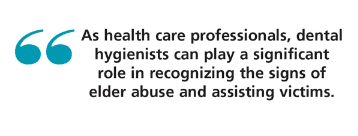Treasure Our Seniors
My father in law turned 99 in February. Since my husband, Mike, and I recently moved to the town where he lives, we’ve enjoyed spending additional time with him.
My father-in-law turned 99 in February. Since my husband, Mike, and I recently moved to the town where he lives, we’ve enjoyed spending additional time with him. Three times a week we have dinner with Dad at the senior facility where he resides and while he can’t hear very well and is often tired, he’s always glad to see us. We feel so fortunate to still have him in our lives.

That’s why I found the article “Addressing Elder Abuse” in this month’s issue so disturbing. I’ve always treasured and respected our elders. In fact, before my mother passed away at 92, I spent as much time as possible with her and considered it an honor to care for her. It’s anathema to me that anyone could abuse an older adult. Unfortunately, elder abuse occurs throughout the United States and beyond, disproportionately affecting those who are most vulnerable. It’s difficult to get accurate statistics on the prevalence of elder abuse. There seems to be less emphasis on reporting abuse of older adults than other populations. The National Center on Elder Abuse estimates there is an average of 2.1 million elder abuse cases each year, with 9.5% of the older adult population experiencing some type of mistreatment.1 The abuse can be physical, emotional, neglectful, or financial, to name only a few. The most likely victims are individuals who are most dependent on care, such as those with cognitive or physical impairments. Women are also more susceptible. And the abuser is most likely a caregiver—a family member or a paid attendant. A 2001 ABC News story generated a great deal of alarm when it reported that 30% of nursing homes in the US were cited for almost 9,000 instances of abuse over a 2-year period. The citations involved untreated bedsores, inadequate medical care, malnutrition, dehydration, preventable accidents, inadequate sanitation and hygiene, and more.2 This begs the question: has the situation improved since then? We can only hope so. But with a growing older adult population that needs assistance coupled with increasingly stressed caregivers, this issue remains a national concern.
 We can no longer turn a blind eye to the problem of elder abuse. As health care professionals, dental hygienists can play a significant role in recognizing the signs of elder abuse and assisting victims. We owe that to our seniors who have given so much to us.
We can no longer turn a blind eye to the problem of elder abuse. As health care professionals, dental hygienists can play a significant role in recognizing the signs of elder abuse and assisting victims. We owe that to our seniors who have given so much to us.
Jill Rethman, RDH, BA
Editor in Chief
jrethman@belmontpublications.com
REFERENCES
- Statistic Brain Research Institute. Elderly Abuse Statistics. Available at: statisticbrain.com/elderly-abusestatistics.Accessed April 21, 2015.
- ABC News. Elderly Abused at 1 in 3 Nursing Homes: Report. Available at: abcnews.go.com/US/story?id=92689. Accessed April 21, 2015.
From Dimensions of Dental Hygiene. May 2015;13(5):10.

